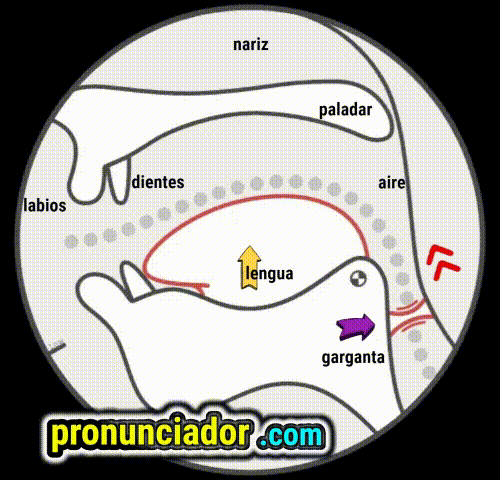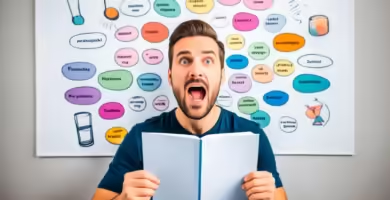
Confusing ‘his’ with ‘hiss’? Stop saying /s/ for /z/! Learn the #1 ‘throat buzz’ trick to master the Z sound and discover why ‘is’ & ‘dogs’ have a buzz
Hey American accent superstars! Get ready to add some serious BUZZ to your English with a sound that’s super common but often a sneaky troublemaker for learners: the /z/ sound, as in “zoo,” “zebra,” “buzz,” or in a TON of words spelled with ‘S’ like “is,” “was,” “has,” or “dogs“! Its phonetic symbol is easy: /z/!
Now, the /z/ sound is like the twin brother of the /s/ “snake hiss” sound. They are made with your mouth in the EXACT SAME POSITION! So, if you can make a good hissy /s/ (like in “sun”), you’re 90% of the way to a perfect /z/! The problem? That last 10% is EVERYTHING, and it all happens in your throat!
What “Z”-any mistakes do learners make?
- The #1 Problem: THE SILENT “Z”! (No Buzz!) This is the BIGGEST issue by far! Your “zoo” comes out sounding like “soo.” Your “buzz” sounds like “bus.” Your “is” sounds like “iss.” You’re making the /s/ mouth shape perfectly, but you forgot to TURN ON YOUR VOICE BOX (vocal cords)!
- The “S-for-Z” Spelling Blind Spot: Did you know that the letter ‘S’ is ACTUALLY the MOST COMMON spelling for the /z/ sound in English words?! Mind-blowing, right? Words like “is,” “was,” “has,” “his,” “easy,” “busy,” and plural -s in “dogs” or verb -s in “runs” ALL use the /z/ sound! Many learners see ‘S’ and automatically make an /s/ sound, missing the crucial /z/ buzz.
- The “Weak Wiggle Z”: Maybe you get a tiny bit of voice, but your /z/ sounds weak, short, or inconsistent, without that strong, continuous friction and buzz.
- The “B/D Substitution”: For learners whose native language doesn’t have /z/ or /s/ fricatives, sometimes a /b/ or /d/ might pop out instead, though this is less common than the S/Z confusion.
It’s super frustrating when “his” and “hiss” sound the same in your speech, or when you just can’t get that lively, buzzy quality that makes American English sound so dynamic!
But DON’T let the /z/ sound give you the “pronunciation blues”! Today, you’re going to become a “Z”-illionaire of pronunciation confidence! This ultimate, SUPER-EASY guide (so clear your pet goldfish could almost get it!) will unlock EVERYTHING about the American /z/:
- Meet the “Buzzy Bee” /z/: What IS this “tongue-tip-hiss-WITH-VOICE-ON!” sound?
- The #1 UNDISPUTED SECRET: S vs. Z = VOICE OFF vs. VOICE ON! This is your golden key!
- Mouth Moves for a “Z”-appy /z/ (Kid-Friendly!): Step-by-step, how to make the /z/ EXACTLY like /s/… but then add the BUZZ!
- The GREAT “S” Deception! When does ‘S’ Magically Sound Like /z/? We’ll reveal the SIMPLE RULES (after voiced sounds, between vowels, key words)! This is HUGE.
- Other “Z” Spellings: Z, ZZ, X as /gz/… we cover those too!
- Vowel Length Power-Up! A secret trick to make your /s/ vs /z/ even clearer!
- Zap Common “Z”-ero Effort Mistakes! Stop that accidental /s/ and get your buzz on!
- “Amazing Zebras!” Practice Power! Fun drills with TONS of common words (‘is’, ‘was’, ‘has’, ‘his’, ‘because’, ‘please’, ‘easy’, ‘zoo’, ‘buzz’) to make your American /z/ absolutely “z”-ensational!
Get ready for your “easy,” “crazy,” “music,” and “always” to have that authentic American ZING! Let’s get buzzy! 🐝🎶
Unpacking the American /z/ “ZOO” Sound: The “Hissy S” with a BUZZ!
Let’s properly get to know this vibrant consonant. The /z/ sound is a core part of American English, and you’ll hear it in a gazillion common words! Like its quiet twin /s/, the /z/ is one of the nine Fricative Consonants in American English. Remember, “Fricative” just means a sound made by squeezing air through a narrow channel in your mouth, creating audible friction (a hissing or, in this case, buzzing sound!). And yes, you can hold this one too: “Zzzzzzzzzzzzz.”
Its “Z”-sential Features (Super Simply Explained!)
The sound experts call /z/ an “alveolar, voiced, fricative consonant.” Let’s make that as easy as A-B-Z!
- Alveolar (TONGUE TIP NEAR Bumpy Ridge!): This is EXACTLY like the /s/ sound! “Alveolar” means the main action happens at your alveolar ridge – that bumpy area right behind your upper front teeth. Your tongue tip (or the flat blade part just behind it) gets super close to this ridge, but IT DOES NOT TOUCH! A tiny gap must remain.
- VOICED (THROAT BUZZER MUST BE ON!!!): This is THE ONLY THING that makes /z/ different from /s/! Your vocal cords (your voice box engine in your throat) MUST be VIBRATING powerfully when you make the /z/ sound. Put your fingers gently on your throat and make a long “Zzzzzzzzz”—you should feel a very strong, continuous BUZZ! Like a happy little bee!
- Fricative (Narrow BUZZY Air Stream!): The voiced air is forced through that very narrow groove or channel created by your tongue tip nearing the alveolar ridge. This makes the air “fizz” or “buzz” with audible friction as it escapes. The airflow MUST be CONTINUOUS.
- Lips (Relaxed or Slightest Smile): Just like for /s/, your lips are generally neutral and relaxed, or they can stretch slightly to the sides (a very subtle, flat smile). Definitely NO rounding!
Kid-Friendly “Buzzy Bee” Summary for /z/:
- Open your mouth just a tiny crack.
- Let your lips be relaxed or make a super tiny flat smile.
- Bring your tongue tip up VERY CLOSE to that bumpy place behind your top teeth, but DON’T LET IT TOUCH! (Tiny air tunnel!).
- Now, here’s the magic: TURN ON YOUR VOICE MOTOR in your throat and make it BUZZ like a bee!
- Gently blow that BUZZY air continuously through the tiny tunnel over your tongue! “Zzzzzzzzz!” Like a friendly bee flying by!
The ULTIMATE Sound Clash: /z/ (Zoo – VOICE ON!) vs. /s/ (Sue – VOICE OFF!)
This is IT! If you get this, you get 95% of the /z/ sound! They are PERFECT TWINS in terms of MOUTH & TONGUE POSITION!
THE ONLY DIFFERENCE = THE THROAT BUZZ (VOICING)!
| Feature | /z/ (Zoo, Buzz, Rise, Phase) | /s/ (Sue, Bus, Rice, Face) |
| Tongue Tip NEAR Ridge? | YES! (Narrow gap for air) | YES! (Narrow gap for air) |
| Continuous Airflow? | YES! (“zzzzzz”) | YES! (“ssssss”) |
| THROAT BUZZING (VOICE)? | ON! (VOICED – MUST BUZZ!) | OFF! (VOICELESS – Quiet Air!) |
| Vowel Length BEFORE? | Vowel usually LONGER (e.g., eyes) | Vowel usually SHORTER (e.g., ice) |
The #1 Non-Native Nightmare: Devoicing /z/ to /s/! Using no voice (making /s/) when you should be using voice (for /z/). This is ESPECIALLY common when ‘S’ (or Z) is at the END of a word, or between vowels.
- “Buzz” /bʌz/ accidentally sounds like “Bus” /bʌs/.
- “Prize” /praɪz/ (premio) sounds like “Price” /praɪs/ (precio).
- “Rise” /raɪz/ (levantarse) sounds like “Rice” /raɪs/ (arroz).
The Golden Solution: THE THROAT BUZZ TEST! Again, your fingers on your throat are your truth detector! - Say “zoo” /zu/. Hold that “Zzzzzz.” Feel the STRONG BUZZ! That’s your voiced /z/!
- Say “sue” /su/ (a name). Hold that “Ssssss.” Feel just AIR, NO BUZZ! That’s your voiceless /s/!
Drill this on/off voice switch until you are the BOSS of your BUZZ!
Your Mouth’s “Buzzy Bee” Mission: Making the /z/ Sound (So Easy!)
Ready to make that awesome American “Zzzzz”? It’s exactly like making /s/, just with your voice motor humming! [2:55 (Video for Z) Articulation for /z/ matches /s/ steps but explicitly adds “vibrate vocal cords”].
Step 1: Mouth – Just a Wee Bit Open!
Relax your jaw. Your mouth should only be slightly open. Just enough for the sound to escape.
Step 2: Lips – Natural & Relaxed (or tiny flat smile).
- Let your lips be in a neutral, relaxed state.
- OR, you can stretch them just a little bit to the sides, like a very faint, unforced smile.
- Definitely NO lip rounding!
Step 3: Tongue Tip – The “Almost Touch” at the Ridge!
This is the /s/ and /z/ hotspot!
- Raise the TIP (or flat blade) of your tongue so it gets VERY CLOSE to the ALVEOLAR RIDGE (that bumpy bit just behind your top front teeth).
- CRITICAL! DO NOT LET YOUR TONGUE ACTUALLY TOUCH THE RIDGE! You need a tiny, narrow channel or gap right in the middle for the air to squeeze through. If it touches, you’ll block the air and get a /d/-like sound (if voiced) or /t/-like (if voiceless), not the hissy/buzzy fricative!
- The sides of your tongue often make light contact with your upper side teeth, helping form that central groove for the airflow.
Step 4: Turn ON THE THROAT BUZZ! (Voiced!)
- This is where /z/ comes alive! Before or AS you send the air through, get your VOCAL CORDS VIBRATING strongly. Feel that unmistakable “zzzzzz” hum in your throat.
Step 5: The BUZZY Air Stream! (Continuous Voiced Friction!)
- With your tongue tip almost touching the ridge AND your voice ON, push a steady stream of that BUZZING air FORWARD over your tongue and out through that tiny central gap.
- You should create a clear, sharp, BUZZING or FIZZING sound of friction. “Zzzzzzzzzzz.”
- It MUST be a CONTINUOUS sound that you can hold.
Putting It All Together: Kid-Friendly “Lazy Bee” Cue!
“Okay, let’s be a lazy, buzzing bee! Put your tongue tip almost touching that bumpy bit behind your top teeth, but don’t let it land! Now, start humming softly in your throat like a sleepy bee ‘mmmmmm’. Keep that hum going, and now let the buzzy air slowly hiss out over your tongue: ‘Zzzzzzzzzzz!’ Your lips are just chilling out. That’s your /z/!”
Key Feeling: Tip of tongue extremely close to (but not touching!) the ridge, forming a tiny channel. Continuous, sharp, BUZZING airflow. Lips neutral/slightly spread. STRONG throat vibration. It feels like a hissy /s/ but with your whole throat vibrating!
ViThe Great “S” Disguise! How the /z/ Sound Is REALLY Spelled (S > Z!)
Get ready for a pronunciation shocker! You’d think the /z/ sound is mostly spelled with ‘Z’, right? WRONG! This is one of the trickiest (but most important!) spelling-to-sound rules in English!
The UNDISPUTED RULER for /z/ Sound: The Letter ‘S’!! (~72%)
Believe it or not, the LETTER ‘S’ is BY FAR the most common way the /z/ SOUND is spelled in American English! About 72% of the time! This blows many learners’ minds!
Here are the KEY situations when written ‘S’ sounds like /z/:
- 1. Final ‘S’ after a VOICED Sound (Plurals, Possessives, Verbs): This is HUGE!
- Plurals: dogs /dɔɡz/, crabs /kræbz/, beds /bɛdz/, trees /triz/, ideas /aɪˈdiəz/, gloves /ɡlʌvz/.
- Possessives: Tom’s /tɑmz/, Pam’s /pæmz/, Dad’s /dædz/.
- 3rd Person Singular Verbs: runs /rʌnz/, sees /siz/, plays /pleɪz/, lives /lɪvz/, comes /kʌmz/.
- (If the sound BEFORE the final ‘s’ is VOICELESS (like /p,t,k,f,θ/), then the ‘s’ stays VOICELESS /s/: cats /kæts/, laughs /læfs/). This is a fundamental voicing assimilation rule!
- 2. ‘S’ Between Two VOWEL Sounds (Intervocalic S): Often /z/!
- easy /ˈizi/, busy /ˈbɪzi/, noise /nɔɪz/, music /ˈmjuzɪk/, please /pliz/, cheese /tʃiz/, rose /roʊz/, use (verb) /juz/, close (verb) /kloʊz/, cause /kɔz/, pause /pɔz/, television /ˈtɛləvɪʒən/ (Here S is /ʒ/ due to -ION, different from plain /z/!). -> Focus on clearer /z/ examples: pre**s**ent (verb) /prɪˈzɛnt/, re**s**ult /rɪˈzʌlt/, de**s**ign /dɪˈzaɪn/, vi**s**it /ˈvɪzɪt/, poi**s**on /ˈpɔɪzən/, rea**s**on /ˈrizən/.
- (Careful! This isn’t 100%. Some intervocalic ‘S’ stay /s/, like “basic” /ˈbeɪsɪk/, “mis-” prefix words like “misuse” /mɪsˈjus/ where the ‘s’ in ‘mis’ is part of the prefix boundary.)
- 3. In MANY Common Function Words & Others: These just need to be learned!
- is /ɪz/
- was /wʌz/ or /wɑz/
- as /æz/ or /əz/
- has /hæz/ or /həz/
- his /hɪz/
- these /ðiz/
- those /ðoʊz/
- because /bɪˈkʌz/ or /bɪˈkɔz/
- always /ˈɔlweɪz/ or /ˈɔlwɪz/
Letter ‘Z’ – The Obvious (But LESS Common!) One (~24%)
Yes, the letter ‘Z’ almost always represents the /z/ sound, but it’s just not as common in English words as ‘S’ representing /z/!
- zoo, zebra, zero, zip, zone.
- amaze /əˈmeɪz/, amazing /əˈmeɪzɪŋ/.
- lazy /ˈleɪzi/, crazy /ˈkreɪzi/.
- freeze /friz/, sneeze /sniz/, squeeze /skwiz/.
- prize /praɪz/, size /saɪz/.
- puzzle /ˈpʌzəl/ (ZZ usually also /z/, though often medial rather than just Z).
Double ‘ZZ’ – Always One /z/ Buzz!
Like other doubled consonants, ‘ZZ’ just makes one clear /z/ sound.
- Buzz /bʌz/
- Fuzz /fʌz/
- Jazz /dʒæz/
- Pizza /ˈpitsə/ (Here TZ often simplified to /ts/ by some speakers, but Z is voiced!) -> For pure ZZ: puzzle, dizzy, frizzle.
- (Source pie chart puts “buzz, dessert” under an “etc” red slice that might be double letters or other rarities. Let’s keep focus on common words).
Letter ‘X’ as /ɡz/ (Has a /z/ Component!) (~4%)
Remember ‘X’ can be /ks/ (box)? Well, when ‘X’ is between vowels and the following vowel is STRESSED, it often makes the VOICED /ɡz/ sound! The second part is our /z/ buzz!
- Exact /ɪɡˈzækt/ (Sounds like “ig-ZAKT”)
- Exam /ɪɡˈzæm/ (“ig-ZAM”)
- Exist /ɪɡˈzɪst/ (“ig-ZIST”)
- Example /ɪɡˈzæmpəl/ (“ig-ZAMPLE”)
- Exaggerate /ɪɡˈzædʒəreɪt/ (“ig-ZADGE-erate”)
Super “Z” Spelling Cheat Sheet (Key Patterns!):
- ‘S’ IS THE BOSS! (After Voiced Sound, Between Vowels, Common Words like IS, WAS, AS, HAS, HIS). ~72%
- ‘Z’: What you expect! (Zoo, Zero, Size, Prize). ~24%
- ‘ZZ’: One /z/ (Buzz, Puzzle). (Often grouped with ‘Z’).
- ‘X’: Sometimes /ɡz/ (Exam, Exact). Includes /z/. ~4%
- Very Rare Exception: ‘F’ in “of” /əv/.
The BIG Takeaway: Don’t just assume ‘S’ is /s/! LISTEN for that BUZZ! Many, many ‘S’ spellings are actually the /z/ sound in American English!
“Z”-ero Mistakes! Common /z/ Goofs & Quick Fixes!
Where do learners often lose their /z/ buzz?
- MISTAKE #1: THE BIGGEST – DEVOICING! (Saying /s/ instead of /z/)
- The Problem: Your throat motor is OFF! Vocal cords not vibrating. So “Zoo” sounds like “Soo,” “Buzz” like “Bus,” “Is” like “Iss.” THIS IS EXTREMELY COMMON, especially when ‘S’ is the spelling for /z/ or at the end of words.
- THE #1 FIX: TURN ON THE BUZZ! FEEL THE VIBRATION! Put your hand on your throat. “Zzzzzzz” MUST buzz. “Sssssss” must NOT. This is non-negotiable for a clear /z/. Drill those minimal pairs (“rice” vs “rise”) relentlessly!
- MISTAKE #2: Not Making a Clear FRICATIVE (Air Squeeze)!
- The Glitch: Your tongue might be too far from the alveolar ridge (not enough friction, sounds weak or like nothing) OR it might be TOUCHING the ridge (making a /d/ sound instead – e.g., “Zoo” sounds like “Doo”).
- The Fix: FIND THE “ALMOST-TOUCHING” SWEET SPOT! Tongue tip very NEAR the ridge, making a tiny channel. Air must SQUEEZE through CONTINUOUSLY with voiced friction. “Zzzzz,” not “Duh-duh-duh.”
- MISTAKE #3: Using a different VOICED FRICATIVE (like Voiced TH /ð/ or /ʒ/ “vision”).
- Uh-Oh: This is if your tongue is in the wrong place for the friction.
- If tongue tip is BETWEEN teeth → sounds like /ð/ (“this”). So “Zen” might become “then.”
- If tongue blade is too FAR BACK (and lips round) → sounds like /ʒ/ (“vision”). So “seizure” (has /ʒ/) vs “Caesar” (has /z/, often). This is less common than the /ð/ confusion for /z/.
- The Fix: TONGUE TIP AT THE RIDGE! Keep that tongue tip up behind your top teeth, near the bumpy ridge, for the alveolar /z/.
- Uh-Oh: This is if your tongue is in the wrong place for the friction.
- MISTAKE #4: Ignoring VOWEL LENGTH before final /z/.
- Problem: Saying the vowel too quickly before a final /z/, which can make the /z/ itself sound shorter or even encourage devoicing to /s/.
- Solution: STRETCH THAT VOWEL A BIT! Vowels are typically held slightly LONGER before voiced consonants like /z/ compared to voiceless ones like /s/. Example: “Eyes” /aɪz/ (longer /aɪ/) vs. “Ice” /aɪs/ (shorter /aɪ/). It’s subtle but adds to naturalness.
- MISTAKE #5: Getting Overwhelmed by ‘S’ as /z/ Spelling Rules.
- Problem: Just defaulting to /s/ for all ‘S’ letters.
- Solution:LEARN THE KEY PATTERNS!
- ‘S’ after a VOICED sound (plurals, verbs) = /z/ (dogs, runs).
- ‘S’ BETWEEN VOWELS = often /z/ (easy, busy, reason).
- MEMORIZE common ‘S’=/z/ words: is, was, as, has, his, these, those, because, please.
- And “of” = /əv/!
“Zoom In!” Practice Drills for Your Awesome American /z/!
Time to make that throat buzz and air fizz perfectly!
Exercise 1: The “Buzzy Bee” Warm-up – Just Pure /z/!
- Tongue tip super close to (but NOT touching!) alveolar ridge. Tiny air channel. Lips neutral/slight spread.
- TURN ON YOUR VOICE MOTOR (THROAT BUZZ)!
- Make a long, steady, LOUD buzzing sound: “Zzzzzzzzzzzzzzzzzzzzz…”
- Hold it for 5-10 seconds. Feel the vibration in your throat AND around your mouth/teeth from the friction! If it stops buzzing and becomes Ssss, your voice turned off!
Exercise 2: The S vs. Z VOICING BOOTCAMP! (THE ULTIMATE DRILL!)
Keep your mouth position EXACTLY the same. Switch only your VOICE ON and OFF! Hand on throat!
- Sue /su/ (NO BUZZ) — Zoo /zu/ (BUZZ!)
- Bus /bʌs/ (NO BUZZ) — Buzz /bʌz/ (BUZZ!)
- Rice /raɪs/ (NO BUZZ) — Rise /raɪz/ (BUZZ!)
- Price /praɪs/ (NO BUZZ) — Prize /praɪz/ (BUZZ!)
- Face /feɪs/ (NO BUZZ) — Phase /feɪz/ (BUZZ!)
- Peace /pis/ (NO BUZZ) — Peas /piz/ (BUZZ!) (Peas plural uses /z/)
- Seal /sil/ (ends in /l/!) — Zeal /zil/ (BUZZ!)
- Hiss /hɪs/ (NO BUZZ) — His /hɪz/ (BUZZ!)
This drill is your #1 key to mastering /z/!
Exercise 3: “S as Z” Pattern Power! (Practice the Common Rules)
- Final S after VOICED sounds = /z/:
- Dogs /dɔɡz/, beds /bɛdz/, gloves /ɡlʌvz/, games /ɡeɪmz/, ideas /aɪˈdiəz/, runs /rʌnz/, plays /pleɪz/, lives /lɪvz/, sees /siz/.
- S Between VOWELS (often /z/):
- Easy /ˈizi/, busy /ˈbɪzi/, music /ˈmjuzɪk/, visit /ˈvɪzɪt/, present (verb) /prɪˈzɛnt/, result /rɪˈzʌlt/, design /dɪˈzaɪn/, reason /ˈrizən/.
- Common ‘S’=/z/’ Words:
- Is /ɪz/, was /wʌz/, as /æz/, has /hæz/, his /hɪz/, these /ðiz/, those /ðoʊz/, because /bɪˈkʌz/, please /pliz/, always /ˈɔlweɪz/, use (verb) /juz/.
Exercise 4: Words Spelled with ‘Z’ or ‘ZZ’
These are more obvious, so focus on the strong buzz and good friction!
- Zoo, zebra, zero, zip, zone, prize, size, amaze, amazing, freeze, sneeze, squeeze.
- Buzz, fuzz, jazz, puzzle, dizzy, whizz.
Exercise 5: “X as /gz/” Practice (Feel Both G+Z!)
- Exact /ɪɡˈzækt/, exam /ɪɡˈzæm/, exist /ɪɡˈzɪst/, example /ɪɡˈzæmpəl/, executive /ɪɡˈzɛkjətɪv/.
- (Focus on the G-stop then the Z-buzz).
Exercise 6: The Indispensable “of” /əv/!
- A cup of /əv/ coffee. A lot of /əv/ things. Because of /əv/ you.
Exercise 7: Source Top 30 “Z” Workout!
| PHONETICAL PRONUNCIATION |
| PHONETICAL PRONUNCIATION |
For EACH one, ask:
- Is my throat BUZZING strongly?
- Is my tongue tip NEAR (not on!) the alveolar ridge?
- Is the airflow CONTINUOUS and FRICTION-FILLED?
- Is the vowel before a final /z/ slightly LONGER?
RECORD & BE YOUR OWN “Z”-CRITIC!
FAQs: Your American /z/ (“Zoo,” “Is”) Questions Answered!
Q1: What’s the #1 difference between the American S /s/ and Z /z/ sounds?
VOICING! (The Throat Buzz!) They are made with the exact same mouth, lip, and tongue position (tongue tip near the ridge behind your top teeth, creating a narrow channel for air).
- /s/ (“sun,” “see”): VOICE OFF. No vocal cord vibration. Just a quiet hiss.
- /z/ (“zoo,” “buzz”): VOICE ON. Vocal cords VIBRATE. A loud, buzzy hiss.
Put your hand on your throat to feel the difference! This is the absolute key.
Q2: Why is the letter ‘S’ so often pronounced as a /z/ sound in English?!
It’s a super common voicing rule in English called assimilation:
- Word Endings (Plurals, Possessives, Verbs): If the sound before the final ‘s’ is VOICED (like /b, d, g, v, ð, m, n, l, r/ or any vowel), the ‘s’ usually becomes VOICED /z/ to match. Examples: dogs /dɔɡz/, Tom’s /tɑmz/, runs /rʌnz/. (If before is voiceless, ‘s’ stays /s/: cats /kæts/).
- ‘S’ Between Vowels: Often, when ‘s’ is between two vowel sounds within a word, it “borrows” their voicing and becomes /z/. Examples: easy /ˈizi/, music /ˈmjuzɪk/, busy /ˈbɪzi/. (This has exceptions like “basic” /ˈbeɪsɪk/, but it’s a strong tendency).
- Common Function Words: Many very common short words like “is,” “was,” “as,” “has,” “his,” “these,” “those” just happen to be pronounced with /z/. Memorize them!
Q3: My /z/ sounds weak or I can’t keep the buzz going. Any tips?
- MORE AIR, MORE VOICE! Ensure you’re pushing a steady, fairly strong stream of voiced air.
- NARROW THE GAP: Make sure your tongue tip is very close to the alveolar ridge to create good friction. If it’s too open, the buzz and hiss weaken.
- PRACTICE HOLDING IT: “Zzzzzzzzzzzzz.” Can you hold it for 5 seconds with a consistent buzz and airflow? This builds control. Start with “mmmm” (easy voiced sound), then try to turn that “mmmm” into “zzzz” by moving your tongue tip to the /z/ spot while keeping the buzz.
Q4: Is the vowel sound longer before /z/ at the end of a word than before /s/?
Yes, it typically is! This is a subtle but important feature of American English rhythm called the “Vowel Length Rule.” Vowels are generally held a bit LONGER before VOICED consonants (like /z/, /d/, /v/, /b/, /ɡ/) compared to their VOICELESS counterparts (/s/, /t/, /f/, /p/, /k/).
- Examples: “eyes” /aɪz/ (the /aɪ/ is longer) vs. “ice” /aɪs/ (the /aɪ/ is shorter). “Raise” /reɪz/ (longer /eɪ/) vs. “Race” /reɪs/ (shorter /eɪ/).
Mastering this adds a lot of naturalness!
Q5: What about the word “of”? Why F = /v/?
“Of” (usually /əv/) is the most famous, high-frequency irregular spelling where ‘F’ sounds like /v/. It happened due to sound changes over history (it used to be /ɒf/), especially because it’s an unstressed function word. You just have to memorize “of” = /əv/!
Key Takeaways: Your American /z/ Will Be “A-MAZE-ing”!
You’ve successfully explored the buzzing, vibrant world of the American /z/ sound! You know its true identity lies in that crucial THROAT VIBRATION and its surprising tendency to hide behind the letter ‘S’.
Your “Z”-en Master Points:
- /z/ = “Snake Hiss” /s/ MOUTH + THROAT BUZZ ON! (Voiced Alveolar Fricative).
- #1 vs. /s/ = VOICE ON (/z/) vs. VOICE OFF (/s/)! Feel that buzz!
- FRICTION IS KEY! Narrow tongue tip channel for a clear, continuous “zzzz.”
- “S” IS OFTEN /z/! Especially: Final ‘s’ after voiced sounds (dogs), ‘s’ between vowels (easy), & key words (is, was, has).
- VOWELS ARE LONGER before final /z/ (eyes vs ice).
- SPELLING = Z, ZZ (easy!). ‘X’ can be /gz/. The “of” = /əv/ exception!
- #1 MISTAKE = Devoicing to /s/! Turn on your voice motor!
The absolute secret is feeling that strong vocal cord vibration while maintaining the hissy airflow. Keep practicing those /s/ vs. /z/ minimal pairs (“price”/”prize,” “bus”/”buzz”). Record yourself saying those “S as Z” words (“is,” “was,” “dogs,” “easy”). Your American English will sound incredibly clearer, more dynamic, and truly native! You’re on your way to “Z”-best!
👇🔥👇🔥👇🔥👇🔥👇🔥👇🔥
👉 RETURNS in the YEAR 2031 ! WHO? CLICK HERE ! 🔥
Dictionary & Pronunciation translator for english speakers (US,UK)
👇🔥👇🔥👇🔥👇🔥👇🔥👇🔥
Diccionario y Traductor de Pronunciación para hispanohablantes (español)
Phonetic Pronunciation Dictionary
Ready to improve?
Enter an English word above to see its detailed pronunciation and video examples.
Finding pronunciation...
👉 RETURNS in the YEAR 2031 ! WHO? CLICK HERE ! 🔥
👇🔥👇🔥👇🔥👇🔥👇🔥👇🔥
Spanish Pronunciation Guide
Instant, easy-to-pronounce translation into Spanish for English speakers.
👇🔥👇🔥👇🔥👇🔥👇🔥👇🔥
👉 RETURNS in the YEAR 2031 ! WHO? CLICK HERE ! 🔥
👇🔥👇🔥👇🔥👇🔥👇🔥👇🔥
¿Cómo se pronuncian los números y letras del abecedario | alfabeto en inglés? descubrelo aqui:
👇🔥👇🔥👇🔥👇🔥👇🔥👇🔥
👉 ¡ REGRESA EN EL AÑO 2031 ! ¿QUIEN? ENTERATE AQUI ! 🔥
👉 ¡ REGRESA EN EL AÑO 2031 ! ¿QUIEN? ENTERATE AQUI ! 🔥
👇🔥👇🔥👇🔥👇🔥👇🔥👇🔥
👉 RETURNS in the YEAR 2031 ! WHO? CLICK HERE ! 🔥
👉 RETURNS in the YEAR 2031 ! WHO? CLICK HERE ! 🔥
👉 RETURNS in the YEAR 2031 ! WHO? CLICK HERE ! 🔥












